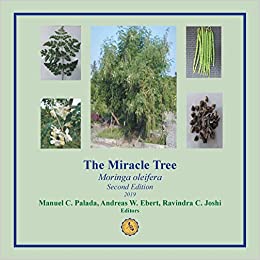Biomass yield of Moringa oleifera as influenced by plant density and harvest frequency

Request
Request a full text copyPage views
488Petsa
2017-05-09Magbahagi
Metadata
Ipakita ang buong tala ng item
Abstract
This study was conducted to determine the leaf biomass of moringa as influenced by plant density and frequency of pruning. Moringa plants were grown at four plant spacings and densities: a) 1×1 m (10,000 plants ha-1 - pph); b) 1×0.5 m (20,000 pph); c) 0.9×0.37 m (30,000 pph) and d) 0.5×0.5 m (40,000 pph), and harvested at three frequencies: 4, 6, and 8 weeks after first pruning for all treatments. The field trial was established and evaluated in a factorial randomized block design with three replications. Moringa seeds of cultivar 'PKM-1' were directly sown in various plots on December 12, 2013. Furrow and sprinkler irrigation were applied once per week to maintain optimum soil moisture for germination and seedling growth. Triple 14 fertilizer was applied at the rate of one tablespoon per plant three weeks after emergence. Seed germination was recorded 10 days after sowing and plant height was measured on a periodic basis. Initial pruning for all treatments was performed to a height of 1 m when plants reached 2 m at 116 days after sowing. Thereafter, harvesting frequencies were followed according to treatments. Results on leaf biomass indicated no increasing trend in leaf fresh biomass with increasing plant density except at 8-week harvest frequency. Highest fresh biomass of 30 t ha-1 was obtained from 40,000 pph harvested at 8-week interval. The lowest fresh leaf biomass was obtained at 10,000 pph. Data on fresh leaf biomass from plants harvested at 4- and 6-week interval at high density (40,000 pph) suggest that these treatments are optimum when there is a monthly demand for fresh raw materials for leaf processing into moringa by-product.
Paglalarawan
Conference paper
Mungkahing Sipi
Patricio, H. G., Palada, M. C., Deloso, H. E., & Garcia, D. E. (2017). Biomass yield of Moringa oleifera as influenced by plant density and harvest frequency. In Ebert, A.W. & Palada, M.C. (Eds.), I International Symposium on Moringa 1158 (pp. 97-103). International Society for Horticultural Science. https://doi.org/10.17660/ActaHortic.2017.1158.12
Uri
Conference paperISSN
0567-7572; 2406-6168ISBN
978-94-62611-55-9Mga Paksa
Mga keyword
Serye
ISHS Acta Horticulturae;1158Collections
Mga parehong item
Ipinapakita ang mga item na nauugnay sa pamagat, may-akda, tagalikha at paksa.
-
A study on the nutritional quality of Moringa oleifera and Moringa peregrina
Palada, Manuel C.; Patricio, Hope G.; Deloso, Homer E.; Paret, Mathews; Garcia, D. E. (International Society for Horticultural Science, 2021-04-15)A study was conducted to determine and compare the growth characteristics and nutritional quality of <em>M. oleifera</em> and <em>M. peregrina</em>. Three moringa cultivars consisting of two <em>M. oleifera</em> cultivars ... -
Comparative study on the antiseptic effects of guava (psidium Guajava), luya (zingiber officinale) and malunggay (moringa oleifera)
Javellana, Bob Rommel J.; Villamor, Ma. Ywomme T. (Central Philippine University, 2010-11)This study was conducted to determine the antiseptic effects of guava (<em>Psidium guajava</em>) leaf extracts, luya (<em>Zingeber officinale</em>) extracts, and malunggay (<em>Moringa oleifera</em>) extracts with betadine ... -
The miracle tree: Moringa oleifera
Palada, Manuel C.; Webert, Andreas W.; Joshi, Ravindra C. (Central Philippine University, 2019)For thousands of years, moringa (Moringa oleifera) has been used as a food crop and as a medicinal plant. Almost all of moringa’s plant parts have multiple uses, particularly the leaves and seed pods, which are highly ...





